The Enchantment of Deep Red Ruby Rings: A Comprehensive Insight
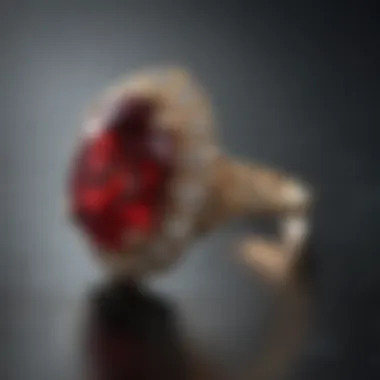
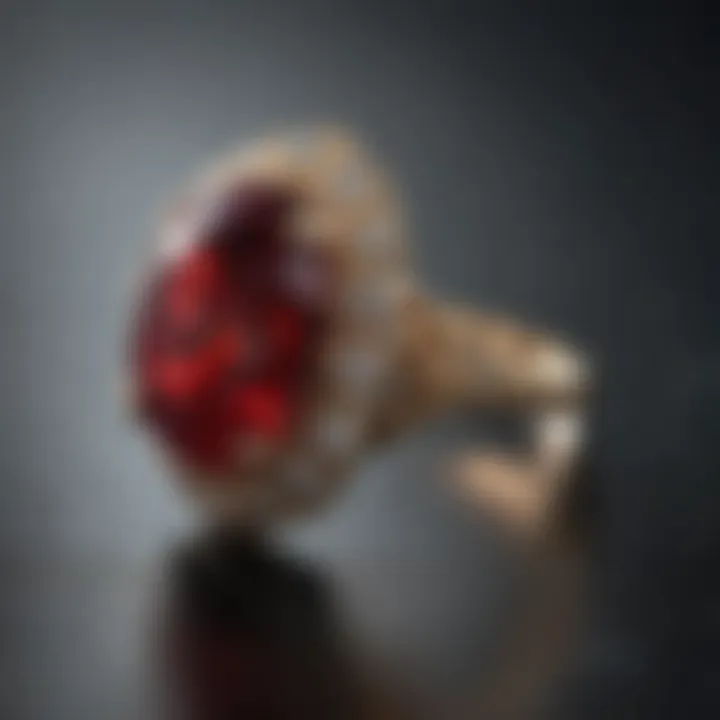
Intro
Ruby rings, particularly those with deep red stones, possess an undeniable charm that captivates jewelry enthusiasts and collectors alike. These vibrant gemstones are not just adornments; they tell a story woven through centuries, cultures, and personal sentiments. Beneath the surface of their stunning appearance lies a complex world shaped by geology, craftsmanship, and emotional resonance.
As we venture into the world of deep red ruby rings, we will uncover their historical significance, delve into the artistry behind their crafting, and explore the meanings attached to these striking gems. This journey aims to enlighten and guide both aficionados and those contemplating their first ruby acquisition.
Gemstone Overview
Definition of Gemstones
At its core, a gemstone is a precious or semi-precious mineral that is cut and polished for use in jewelry or other decorative applications. The allure of gemstones lies in their rarity, beauty, and the sentiments they evoke in people. Ruby, with its intense crimson hue, stands tall among the most prized gemstones in existence. Beyond mere decoration, rubies embody a deeper allure and connection to the earth’s history.
Classification of Gemstones
Gemstones can be classified into two broader categories: precious gemstones and semi-precious gemstones. Ruby falls into the precious category, alongside diamonds, sapphires, and emeralds. They possess unique traits that elevate their market value, such as color saturation, clarity, and size.
When it comes to rubies, the quality is often determined by several factors:
- Color: Deep red is the most sought-after, with a hue often described as "blood-red."
- Clarity: Fewer inclusions allow for a more brilliant appearance.
- Cut: Enhances the stone's sparkle and shape.
- Carat Weight: Larger stones are rarer and demand higher prices.
Understanding these characteristics is essential for both buyers and collectors, as they directly influence the ruby's market value.
Historical Significance
Origins of Gemstone Use
The use of gemstones can be traced back to ancient civilizations, where they were often seen as symbols of power or used in religious practices. Rubies, specifically, have a storied past that intertwines with royalty and mythology. In ancient cultures, they were believed to offer protection and were often worn by warriors for that very reason. There’s even a saying that rubies can bring good fortune and protect against evil spirits.
Cultural Insights: Gemstones in Ancient Civilizations
Different civilizations have taken a notable interest in rubies:
- In India, rubies were known as "ratnaraj," the "king of gems," and were favored by emperors.
- Burmese warriors would embed rubies into their skin, believing that doing so would make them invulnerable in battle.
- In Medieval Europe, rubies were thought to safeguard against misfortunes and were often part of crown jewels.
The emotional and cultural significance of rubies not only adds depth to their allure but also underscores why they continue to be treasured today.
Historical Significance of Rubies
Rubies have long been recognized as one of the most precious gemstones in the world. Their historical significance transcends mere aesthetics; they have played a pivotal role in the cultures and civilizations of many societies. In this article, we will explore the fascinating elements behind the history of rubies, focusing on how they have been revered across different epochs and cultures. The deep red hue of rubies not only captures the eye but also evokes passion, power, and love, making them a symbol of stature and fortitude.
Rubies in Ancient Civilizations
Throughout history, rubies have been cherished by various ancient civilizations. In fact, this gemstone dates as far back as 500 BC, where it was first used by the people of India. The ancient texts, notably the Sanskrit writings, describe rubies as being more valuable than diamonds. They were believed to protect their wearers from harm and to bring them good fortune.
The Burmese believed that anyone who possessed a ruby would be guaranteed victory in battle. As a result, soldiers would implant rubies in their flesh to ensure their triumph on the battlefield. This perspective underlines not just the beauty of rubies, but the profound impact on the lives of those who wore them.
In China, rubies were linked to the concept of power. Emperors would use these stones to symbolize their authority, often adorning their crowns and jewelry with this exquisite gem. The significance of rubies was encapsulated in sayings that suggested these stones could bring peace and drive away evil, enhancing the cultural status they held.
Cultural Symbolism and Myths
The allure of rubies extends beyond their physical properties. Culturally, they have come to symbolize a myriad of ideas across different societies.
- In Hinduism, rubies represent the sun and are connected to life energy. They are thought to embody the power of love and compassion.
- Conversely, in Buddhist cultures, rubies hold a sacred status and are associated with nobility and spirituality. They are often used in religious artifacts.
Myths surrounding rubies are abundant. They are frequently depicted as stones of great value in tales of old. According to one legend, rubies were born from the blood of dragons. This underscores their prowess and rarity. Many cultures believed that rubies would grant their wearers benefits such as increased passion, courage, and wealth.
As we weave through the narrative of rubies throughout the ages, it becomes clear that their historical and cultural significance cannot be overstated. Their presence has inspired stories, art, and jewelry, leaving an indelible mark on human creativity and expression. Rubies, therefore, stand not only as gems to be admired but as historical treasures that continue to captivate both gemstone enthusiasts and casual collectors alike.
"The ruby represents the sun—its fiery hue reflects love and balance, illuminating the past while casting light on the future."
The Geological Origins of Rubies
Understanding the geological origins of rubies provides invaluable context regarding their formation and rarity. This section will explore how rubies are born beneath the earth’s crust and unveil the factors that contribute to their unique attributes. Not only does this information enrich the appreciation for these gems, but it also helps potential buyers identify quality pieces.
Formation Process
Rubies are a variant of corundum, a mineral composed primarily of aluminum oxide. The deep red hue of rubies arises from traces of chromium, which replaces some aluminum in the mineral structure. This replacement is crucial. When the right combination of temperature, pressure, and elemental content occurs, it leads to the formation of rubies over millions of years.
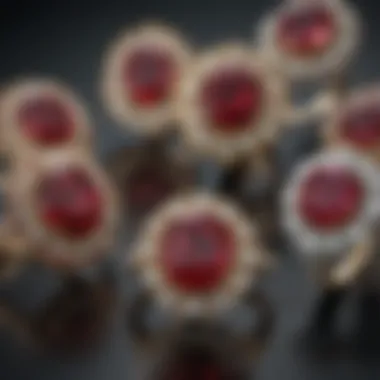
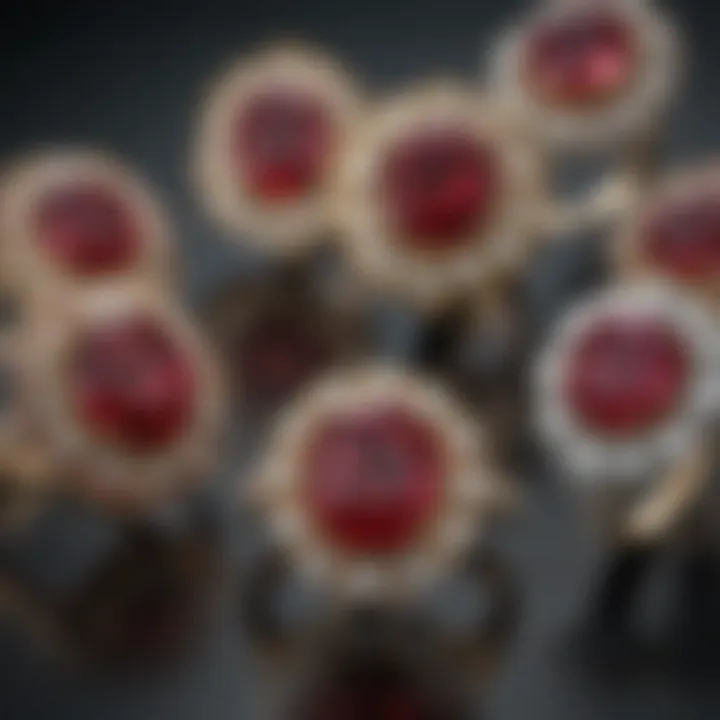
The formation process begins in metamorphic rocks, where existing minerals transform under heat and pressure. Alternatively, rubies can form in igneous environments, emerging from volcanic activity. In both scenarios, a sequence of cooling and crystallization allows the gemstones to form. The unique environmental conditions can lead to variations in color and clarity, making each ruby an individual work of art shaped over time.
"The birth of a ruby is not just about the chemistry; it’s about the Earth telling its story through millions of years of transformation."
Key Locations of Ruby Deposits
Rubies are predominantly found in several key locations around the world, each providing distinct characteristics that elevate the gem's allure. Some of the most renowned ruby-producing regions include:
- Burma (Myanmar): Often celebrated for its vibrant, deep red rubies known as "Burmese rubies," which are particularly prized for their color and clarity. The Mogok Valley remains a significant source, where local craftsmanship often plays a role in the markets.
- Thailand: Known for its colorful ruby stones, though they tend to be less saturated compared to their Burmese counterparts. Thailand's rubies often have a more pinkish hue and are frequently produced through alluvial mining processes.
- Sri Lanka: A location famous for a variety of colored gemstones, including rubies. The unique geological conditions contribute to a spectrum of hues, including more pinkish and orange variants.
- Africa: Several African countries, such as Mozambique and Madagascar, have emerged in recent years as important ruby sources. These regions often yield stones with striking color and notable clarity, contributing to their growing popularity in the market.
- United States: While not known for commercial rubies, small deposits can be found in states like Montana. Here, the rubies are generally less vivid, making them less sought after but still interesting from a geological perspective.
Understanding where rubies originate not only informs enthusiasts about their purchase but also underscores the geographical and historical significance that can enhance the value of a ruby ring.
Understanding Ruby Color and Quality
When diving into the world of ruby rings, color and quality stand as pivotal factors in determining their allure. The vivid crimson of a ruby can draw eyes and evoke emotion, making it crucial to grasp the significance of these aspects. Color not only influences the aesthetic appeal but also significantly impacts the gemstone's value. Understanding how these elements interplay helps buyers make informed decisions and appreciate the artistry involved in crafting ruby rings.
The Importance of Color in Rubies
Color is the heartbeat of a ruby. It can be said that the deeper the red, the more enchanting the stone appears. However, it’s not just the hue itself that matters; the saturation and tone play a vital role in overall quality. A true, deep red ruby is often compared to the vibrant color of fresh blood or the rich hue of a fine Bordeaux wine.
Some crucial points to consider include:
- Hue: Rubies primarily display shades of red. Different hues, like purplish or orangish-red, can influence the stone's desirability.
- Saturation: The intensity of the color significantly adds to the value. Stones with vivid saturation command higher prices.
- Tone: Refers to how light or dark the ruby appears. The best rubies ideally strike a balance, exhibiting a full color depth without leaning too dark or dull.
To further illustrate, let’s say you happen upon a striking ruby ring. If it's a light pinkish-red, while it might have its charm, it doesn’t have the same impact as a deep crimson gem. This differentiation affects both how jewelers price these stones and how potential buyers perceive them emotionally.
"The deeper the red, the more captivating the allure of the ruby."
Clarity, Cut, and Carat Weight Explained
Alongside color, clarity, cut, and carat weight are the three essential components that define a ruby's quality. Focusing on these can greatly enhance your understanding and appreciation for a ruby ring.
- Clarity: This aspect relates to the presence of natural inclusions or blemishes within the stone. While some inclusions are normal, a ruby with fewer imperfections is generally deemed more valuable.
- Cut: The way a ruby is shaped influences how it interacts with light. A well-cut ruby will reflect light elegantly, enhancing its color and brilliance. Various cuts, from classic oval to modern cushion, also affect how the stone is perceived.
- Carat Weight: Simply put, this is the weight of the ruby. Larger rubies are rarer and, therefore, tend to be more expensive. However, it’s not simply about size; a smaller, high-quality ruby can outshine a larger, lesser-quality one with ease. When evaluating a ruby ring, it’s essential to consider these elements together.
These factors—color, clarity, cut, and carat—interconnect like artisans weaving a tapestry of beauty. The right balance is key. When seeking a new ruby ring, keep these aspects in mind for a fulfilling and worthwhile purchase.
Economic Value of Deep Red Rubies
The economic significance of deep red rubies extends far beyond their dazzling appearance. They occupy a unique niche in the gemstone market, presenting both intrinsic and extrinsic value. From the perspective of jewelers and collectors, rubies are not just decorative items; they embody a status symbol and an investment opportunity. In a world where financial stability can often feel elusive, owning a ruby ring can be seen as a tangible asset—one that can appreciate over time, much like real estate or fine art.
Investing in gemstones, particularly rubies, comes with a unique set of benefits. First off, the rarity of high-quality rubies, especially those with a deep red hue, tends to drive up their value. Many jewelers or investors look for rubies that are certified by reputable grading labs to ensure quality, and these certifications can add a layer of assurance in purchase decisions.
The allure of a ruby often lies in its depth of color and brilliance, making it not just a piece of jewelry, but a potential financial asset.
Market Dynamics and Trends
The market for rubies has seen considerable volatility, influenced by various factors including global economic stability, fashion trends, and availability of raw materials. Recent years have witnessed a surge in demand from emerging markets, particularly in Asia, where gemstones are highly valued. This trend has significant implications; as demand intensifies, prices for high-quality rubies tend to push skyward.
Key factors affecting the market include:
- Consumer preferences: As styles and tastes evolve, the palette for gemstones can shift, impacting sales.
- Supply chain challenges: Accessibility of quality rubies has tightened due to mining limitations, driving prices upwards.
- Investment interest: A rising number of individuals see ruby rings as prudent investments, further escalating market demand.
Understanding these dynamics allows potential buyers to make informed decisions. The value held in a deep red ruby ring isn't just in the stone itself; it also encapsulates aspects of economic forces that keep pushing their worth.
Investment Considerations
Investing in rubies requires a discerning eye and careful consideration. The following aspects should guide potential buyers:
- Certification: Always purchase rubies that come with a certification from a recognized gemological laboratory. This assures that the stone's value aligns with the quality presented.
- Color and Clarity: Look for stones with a vivid, deep red color and minimal inclusions. These qualities significantly affect the ruby's market value.
- Trends and Forecasts: Keep an eye on market trends. Understanding consumer behavior can provide insight into whether rubies are likely to appreciate in value.
- Authenticity: The rarity of rubies can unfortunately make the market susceptible to counterfeits. It's crucial to verify the authenticity of the stone to ensure it retains its value.
Craftsmanship Behind Ruby Rings
Craftsmanship is not just a word; it encapsulates the heart and soul that goes into making ruby rings. The intricate details and precise skills involved can transform a simple gemstone into an extraordinary piece of art. In this section, we will dive into key elements that showcase the craftsmanship behind ruby rings, emphasizing how such artistry enhances the allure of these precious stones.
Design Principles in Jewelry Making
Great jewelry design starts with understanding the fundamental principles that guide craftsmanship. These principles—balance, contrast, harmony, proportion, and rhythm—are critical when creating beautiful ruby rings. The balance between the ruby itself and the accompanying metal or diamonds is vital for aesthetic appeal. A well-placed ruby can act like a cherry on top of a cake, drawing the viewer's eye naturally.
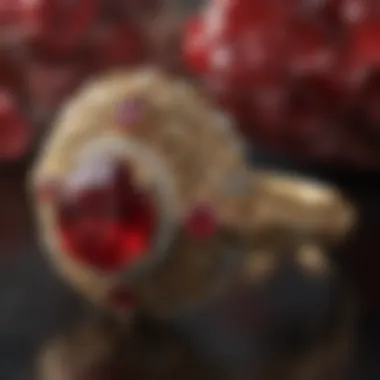
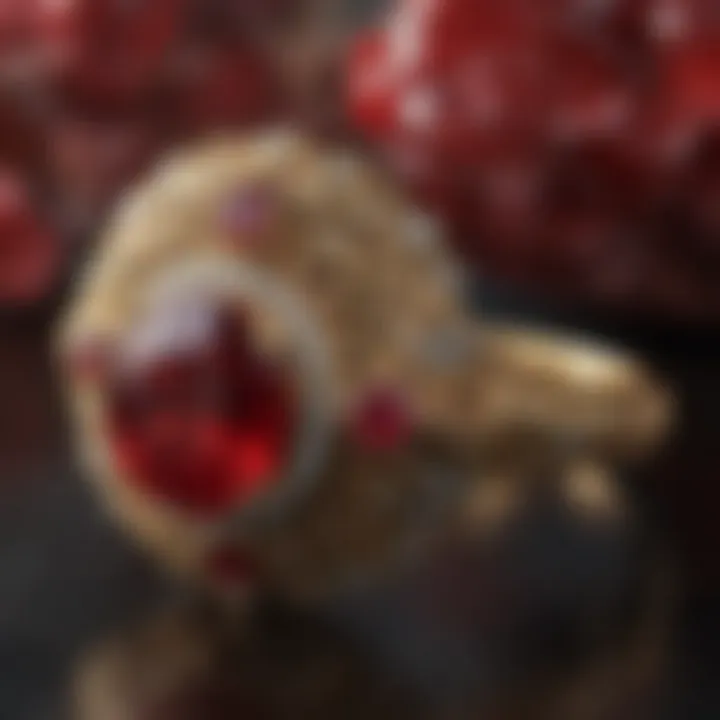
- Contrast can make a ruby ring stand out. Pairing a deep red ruby with white gold or platinum creates a striking image, ensuring the ring grabs attention.
- Harmony ensures that all elements work together. A ring design should convey a seamless flow; when the metal wraps around the stone elegantly, it forms a unity that feels both intentional and beautiful.
- Proportion plays an essential role in the ring's overall look. The size of the ruby versus the band should harmonize to avoid the appearance of something gaudy. A massive ruby set in a thin band might not hold the same elegance as one with a proportional relationship.
Furthermore, the rhythm in the design can impact how the design moves and captures light, adding an extra layer of complexity and beauty. Jewelry is, in many ways, a wearable art form. Each curve, twist, and setting has a story—each piece reflects the jeweler's vision and skill.
Sourcing and Setting Rubies
Sourcing quality rubies is like hunting for buried treasure. Not every ruby shines the same, and the journey from mine to ring involves several meticulous steps. Sourcing rubies from trusted mines ensures that artisans have access to the finest, most vibrant stones. Some of the notable ruby sources include Myanmar, Madagascar, and Thailand. Each of these locations has its unique characteristics that add to the allure of the stones produced.
Setting the ruby is equally crucial and can be a meticulous process. Jewelers use various techniques to secure the gemstone, and the choice of setting—be it prong, bezel, or pave—can dramatically alter the ring's visual impact.
"A proper set ruby behaves like a queen on her throne, drawing admiration while honoring her domain without overpowering the elegance of her surroundings."
When a ruby is set precisely, it enhances the stone's brilliance and maximizes its reflective qualities. Evidence of a skilled artisan often shows in how seamlessly the ruby sits within its setting, appearing as if it is cradled with utmost care.
In summary, the craftsmanship behind ruby rings encapsulates not just the technical skills of the jeweler, but also a rich tapestry of design principles and sourcing experiences that create each distinctive piece. Emphasizing artistry in every stage of production, from sourcing to setting, is key to ensuring these rings remain not only beautiful but truly captivating.
Emotional Significance of Ruby Rings
The emotional significance attached to ruby rings can hardly be overstated. These deep red stones evoke feelings that go beyond aesthetic appeal; they symbolize profound connections and cherished moments in life. The allure of a ruby ring often lies in its ability to convey love, passion, and commitment, making it a significant choice for engagement rings and other meaningful occasions. More than just a piece of jewelry, a ruby ring can serve as a vessel of personal memories and promises.
Rubies as Symbols of Love and Passion
Historically, rubies have been synonymous with love and passion. The rich, crimson hue of the ruby is often likened to the heart's own fiery emotions. It's no wonder that in many cultures, rubies are considered the perfect gift for those special milestones in a relationship. Whether it's a wedding anniversary or a significant birthday, gifting a ruby ring can articulate an array of sentiments, symbolizing commitment and everlasting affection.
"The ruby is the stone of love and passion; the deep color reflects the depth of one's emotions."
Consider Queen Victoria who wore a ruby ring, signifying her deep affection for Prince Albert. This strong emotional attachment has been passed down through generations and has established rubies as a coveted symbol of romantic love. Additionally, many believe that wearing a ruby can enhance feelings of love and compassion, making it a worthy companion in any union.
Cultural Practices Involving Ruby Jewelry
Different cultures have long appreciated rubies not just for their beauty, but for their supposed powers. From ancient Indian beliefs where rubies were thought to bring prosperity and success, to Burmese traditions where warriors wore rubies for protection and invulnerability, the emotional resonance connected to ruby rings these days is but an echo of their storied past.
In contemporary times, ruby jewelry often appears in significant cultural ceremonies. In some African societies, red stones are integrated into dowries, linking them to family and heritage. Likewise, in Chinese culture, rubies have strong meanings associated with love and happiness, making them a popular choice for wedding gifts.
Metaphysical Properties of Rubies
The metaphysical properties of rubies have long fascinated and inspired both jewelers and gemstone enthusiasts. Renowned not only for their striking beauty, deep red rubies are also believed to hold powerful energies and numerous benefits. Understanding these properties can provide a greater appreciation of the ruby rings we admire and wear.
Traditional Beliefs and Healing Powers
Traditionally, rubies have been associated with a myriad of spiritual and healing beliefs. In many cultures, these gemstones were thought to possess protective qualities, creating a shield around the wearer. For instance, in ancient India, rubies were considered the stones of the warrior, instilling courage and confidence. It was widely held that they could even preserve health and vitality.
Many people believe that rubies help to balance the mind and enhance self-awareness.
Their deep red color has also been linked to the heart and blood, which adds to the belief that rubies can invigorate life force and passion. Some say that the stone promotes emotional healing and encourages a vibrant, fulfilling love life. This connection with the heart can make ruby rings particularly appealing as gifts for anniversaries or romantic occasions.
"Rubies are said to spark the fire of love and passion, creating not just adornments, but bonds between hearts."
Modern Interpretations
In today’s world, the understanding of rubies has evolved, blending ancient beliefs with contemporary perspectives. Many modern gemstone enthusiasts view rubies as symbols of success and wealth. The energy of rubies is often seen as invigorating, motivating individuals to pursue their goals and aspirations more boldly.
From a healing arts viewpoint, rubies are connected to the root chakra, which governs strength and stability. Practitioners of crystal healing use rubies to enhance energy levels and promote emotional stability. This has led to a rise in meditation practices, where individuals hold rubies to clear their minds and focus their intentions.
Here are some commonly modern interpretations of ruby properties:
- Energy Amplification: People seek rubies to amplify their own energy and the energy of their intentions.
- Boosting Confidence: Many believe that wearing rubies can help one feel more assured and empowered in social settings.
- Creativity Spark: Some artists use rubies during creative endeavors, hoping to stimulate inspiration and invention.
As individuals dive deeper into metaphysical pursuits, the multifaceted allure of rubies continues to inspire and ignite passion across generations.
Selecting a Quality Ruby Ring
Choosing a ruby ring is not merely a spontaneous splurge, it’s an investment in beauty, meaning, and sometimes, legacy. When it comes to selecting a quality ruby ring, there are several key points to consider that can significantly affect not only the piece’s value but also its enduring beauty. The goal is not just to own a ruby ring, but to ensure that it encapsulates the rich history, craftsmanship, and emotional significance that these gems represent.
What to Consider When Buying
When on the hunt for a ruby ring, first things first, determine your budget. Rubies, especially the deep red ones, range considerably in price. This can sway dramatically based on quality and origin. You might find more budget-friendly options, but do keep in mind that these may not have the vibrancy or durability of higher-quality stones.


Here are a few factors you should ponder:
- Color: The intensity of the red hue plays a crucial role. The most desirable rubies are a deep blood-red, often called ‘pigeon's blood’ rubies. Subtle hints of color appear more vibrant depending on light conditions, so it’s wise to examine them in various lights.
- Clarity: Look closely for inclusions—tiny blemishes that can impact the stone’s overall aesthetics and value. Higher clarity rubies are typically more sought after.
- Cut: The craftsmanship involved in cutting the ruby influences not just beauty but also how it reflects light. Well-cut gems sparkle, making them particularly captivating.
- Carat Weight: Larger rubies are rare and tend to command higher prices, but don't let size be the sole focus. Smaller gems with exceptional quality can outshine larger but inferior stones.
Being equipped with this knowledge can significantly aid in making an informed purchase. You want to feel confident that your selected piece not only reflects your style but also shines with the charm unique to rubies.
Verifying Authenticity
Once you've honed in on the perfect ruby ring, the next step is ensuring its authenticity. The market is rife with imitation stones and treatments that mimic the appearance of genuine rubies without carrying the same value.
Here are a few ways to verify a ruby’s authenticity:
- Certificates: Always request a gemological report from a reputable lab such as the Gemological Institute of America (GIA) or the American Gemological Society (AGS). These documents provide essential details about the stone’s quality and origin.
- Natural vs. Synthetic: Inquiries should be made regarding whether the ruby is natural or lab-created. They might look the same, but natural rubies hold far more value.
- Visual Inspection: Observe the stone under varying light conditions. Genuine rubies often show some characteristics indicating their natural state, such as inclusions and color zoning.
Care and Maintenance of Ruby Rings
Deep red ruby rings represent not only a symbol of elegance and beauty but also an investment that deserves thoughtful care and maintenance. Proper attention to these exquisite pieces enhances their brilliance, preserves their quality over time, and ensures they remain cherished heirlooms for generations. Each rubies gleam and vibrancy can dull with neglect, making knowledge of correct care methods essential for any owner.
Cleaning Techniques
Cleaning your ruby ring should be a routine practice, akin to tuning a finely crafted instrument. Regular cleaning keeps the stone free of grime, oils, and dirt that can accumulate over time. Here are recommended methods for maintaining your ruby's sparkle:
- Gentle Soap Solution: Mix a few drops of mild dish soap with warm water. Soak your ring for 10-15 minutes, then use a soft-bristled brush to gently scrub the stone and setting.
- Microfiber Cloth: After washing, dry your ring with a microfiber cloth to avoid scratching the surface. This material is gentle and won’t leave lint behind.
- Avoid Harsh Chemicals: Stay away from ammonia or bleach; these can cause damage. Remember, rubies are hard but settings can be delicate.
"Taking a few minutes regularly can save you from a troublesome repair job later on."
Storage Guidelines
The way you store your ruby ring directly affects its longevity. Ruby rings should be treated with respect when not being worn. Here are some guidelines to ensure their safety:
- Soft Pouches: Store ruby rings in individual soft pouches to prevent them from scratching each other. A dedicated fabric bag is ideal for this.
- Avoid Extreme Temperatures: Keep your gems at room temperature. High heat can cause stones to crack, while extreme cold might weaken the metal settings.
- Jewelry Box with Dividers: If you have several pieces, consider using a jewelry box with compartments. This keeps everything organized and minimizes the risk of tangling and scratching.
Understanding the care and maintenance of ruby rings is crucial for preserving their beauty and value. Small practices incorporated into your routine can lead to a lifetime of enjoyment of these glorious gemstones.
Ruby Rings in Popular Culture
Deep red ruby rings are not just beautifully crafted pieces of jewelry; they carry cultural significance and historical narratives that have permeated various facets of society, from royal courts to contemporary fashion runways. Their striking hue and perceived rarity give them a certain allure, making them not just ornaments but symbolically rich artifacts. In this section, we will explore two important realms of ruby rings in popular culture: their representation in significant historical moments and their presence in artistic expressions, including literature.
Notable Ruby Jewelry in History
Throughout history, rubies have adorned the fingers of emperors, kings, and queens, making them synonymous with power and prestige. One of the most renowned examples of ruby jewelry occurred during the reign of Queen Elizabeth I of England, known for her love of extravagant accessories. Rumor has it that she sported a stunning ruby ring which not only highlighted her royal status but also served as a talisman believed to protect her from harm.
Another notable instance is the famed "Imperial Ruby Necklace," worn by Empress Dowager Cixi of China. This exquisite piece represents the zenith of craftsmanship and the historical appreciation of rubies in Asian cultures, where they symbolize protection and prosperity. Not to forget the famous "Red Emperor", a ruby ring that was said to belong to Emperor Shah Jahan, the architect of the Taj Mahal. Legends and stories surrounding these historic pieces emphasize the enduring appeal of rubies as symbols of beauty and authority.
Ruby Rings in Art and Literature
Ruby rings have also made their mark in literary works and artistic expressions. Writers and poets have long been captivated by the ruby's deep red color, often using it as a metaphor for love, passion, and even jealousy. In William Shakespeare's plays, rubies were often mentioned alongside other gemstones, symbolizing wealth and desire. A line from a sonnet might invoke the image of a ruby as a representation of undying love, further entrenching its position in romantic narratives.
In more recent times, popular films and novels have also continued to embrace ruby rings as symbols of love and commitment. For instance, in the blockbuster movie "Wild Things", a ruby ring plays a pivotal role, showcasing how such rings can be woven into modern storytelling. This trend showcases the versatility of rubies in varying narratives, highlighting their ability to adapt and thrive in cultural dialogues across centuries.
The persistence of ruby rings in pop culture is evident not only through historical significance but also their resonance in literary and artistic expressions. As both fashionable and symbolic items, they pique the interest of gem enthusiasts, collectors, and storytellers alike, reminding us that a simple ring can encapsulate vast narratives that traverse time and space.
The Future of Ruby Jewelry
As we gaze forward into the crystal ball of ruby jewelry, several pivotal elements stand out, shaping the landscape for gemstone enthusiasts and collectors alike. With deep red rubies captivating an audience that ranges from casual admirers to serious investors, the future is not only about aesthetic design but also revolves around ethical sourcing, sustainability, and innovative craftsmanship. Ruby rings are not just adornments; they are symbols of heritage and personal stories, making their future intriguing and significant.
Emerging Trends in Design
The design of ruby jewelry is inherently tied to changing tastes and preferences. Currently, we see a shift towards more personalized pieces — items that reflect individual narratives. Customization has become a core focus for jewelers aiming to resonate with buyers on a deeper level. Not only are people searching for unique ruby rings that stand out, but also designs that encapsulate personal milestones or values. This trend has led to the rise of:
- Hybrid Styles: A blend of vintage and contemporary design elements, creating a fresh take on traditional ruby jewelry.
- Minimalistic Yet Bold Designs: Simple mounting with a single deep red ruby that commands attention, offering an elegant aesthetic.
- Emotional Motifs: Incorporating symbols or designs that represent personal stories or relationships, making each piece inherently meaningful.
As designers embrace these trends, the dialogue between artistry and sentiment grows stronger, driving demand for unique ruby rings that truly reflect the essence of the wearer.
Technological Advancements in Gemstone Sourcing
With technology evolving at lightning speed, the gemstone industry is undergoing significant changes in sourcing and supply chain management. The future holds promising advancements that can enhance consumer confidence and broaden choices. Here are some noteworthy developments:
- Blockchain Technology: This innovation is fostering transparency in the supply chain. By tracking each stone from mine to market, buyers can verify the authenticity and ethical sourcing of rubies.
- Synthetic Rubies: Growing acceptance of lab-created rubies offers an alternative for buyers seeking quality at lower prices. These gems mimic natural rubies but come without the ethical concerns sometimes associated with mined stones.
- Advanced Gemological Equipment: Enhanced tools for grading and assessing rubies ensure consumers receive accurate information regarding quality and value.
"As technology progresses, the dialogue around ethical sourcing and transparency in gemstone trading will continue to shift, creating a market that consumers can feel proud to engage with."
In summary, the future of ruby jewelry is marked by a convergence of innovative design and technological breakthroughs. This evolution promises not just a shift in how rubies are perceived but transforms them into coveted heirlooms that embody personal stories and ethical practices.
By embracing emerging design trends and adapting to technological changes, ruby rings will continue to capture the imagination of future generations.



